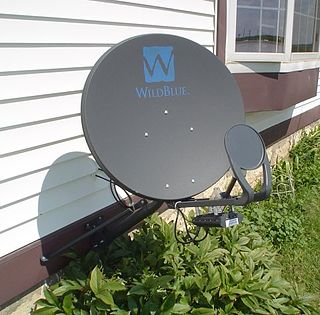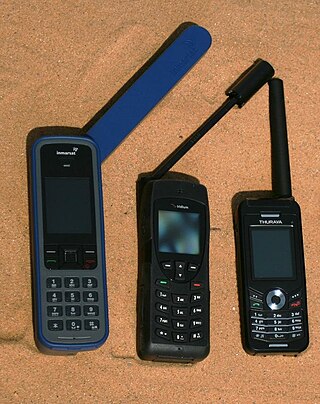
Integrated Services Digital Network (ISDN) is a set of communication standards for simultaneous digital transmission of voice, video, data, and other network services over the digitalised circuits of the public switched telephone network. Work on the standard began in 1980 at Bell Labs and was formally standardized in 1988 in the CCITT "Red Book". By the time the standard was released, newer networking systems with much greater speeds were available, and ISDN saw relatively little uptake in the wider market. One estimate suggests ISDN use peaked at a worldwide total of 25 million subscribers at a time when 1.3 billion analog lines were in use. ISDN has largely been replaced with digital subscriber line (DSL) systems of much higher performance.
Iridium Communications Inc. is a publicly traded American company headquartered in McLean, Virginia, United States. Iridium operates the Iridium satellite constellation, a system of 75 satellites: 66 are active satellites and the remaining nine function as in-orbit spares. Iridium Satellites are used for worldwide voice and data communication from handheld satellite phones, satellite messenger communication devices and integrated transceivers, as well as for two-way satellite messaging service from supported conventional mobile phones. The nearly polar orbit and communication between satellites via inter-satellite links provide global service availability.

In telecommunications, broadband or high speed is the wide-bandwidth data transmission that exploits signals at a wide spread of frequencies or several different simultaneous frequencies, and is used in fast Internet access. The transmission medium can be coaxial cable, optical fiber, wireless Internet (radio), twisted pair cable, or satellite.

Internet access is a facility or service that provides connectivity for a computer, a computer network, or other network device to the Internet, and for individuals or organizations to access or use applications such as email and the World Wide Web. Internet access is offered for sale by an international hierarchy of Internet service providers (ISPs) using various networking technologies. At the retail level, many organizations, including municipal entities, also provide cost-free access to the general public.
The public switched telephone network (PSTN) is the aggregate of the world's telephone networks that are operated by national, regional, or local telephony operators. It provides infrastructure and services for public telephony. The PSTN consists of telephone lines, fiber-optic cables, microwave transmission links, cellular networks, communications satellites, and undersea telephone cables interconnected by switching centers, such as central offices, network tandems, and international gateways, which allow telephone users to communicate with each other.

A satellite telephone, satellite phone or satphone is a type of mobile phone that connects to other phones or the telephone network by radio link through satellites orbiting the Earth instead of terrestrial cell sites, as cellphones do. Therefore, they can work in most geographic locations on the Earth's surface, as long as open sky and the line-of-sight between the phone and the satellite are provided. Depending on the architecture of a particular system, coverage may include the entire Earth or only specific regions. Satellite phones provide similar functionality to terrestrial mobile telephones; voice calling, text messaging, and low-bandwidth Internet access are supported through most systems. The advantage of a satellite phone is that it can be used in such regions where local terrestrial communication infrastructures, such as landline and cellular networks, are not available.

Satellite Internet access is Internet access provided through communication satellites; if it can sustain high speeds, it is termed satellite broadband. Modern consumer grade satellite Internet service is typically provided to individual users through geostationary satellites that can offer relatively high data speeds, with newer satellites using the Ku band to achieve downstream data speeds up to 506 Mbit/s. In addition, new satellite internet constellations are being developed in low-earth orbit to enable low-latency internet access from space.

Inmarsat is a British satellite telecommunications company, offering global mobile services. It provides telephone and data services to users worldwide, via portable or mobile terminals which communicate with ground stations through fifteen geostationary telecommunications satellites.
SITAONAIR is a company that enables airline passengers to use their smart devices including mobile phones and laptops for calls, text messaging, emails and Internet browsing.

Unitel is a Mongolian Corporate Group of information technology companies, headquartered at Central Tower in downtown Ulan Bator, Mongolia. It was founded on December 23, 2005 as BSB consortium as GSM mobile phone operator and began operations on June 26, 2006. As a provider of mobile telephone services, Unitel is the second largest company in terms of subscriber base and 14th largest company in Mongolia as measured by a composite of revenues, profits, assets and taxes. Its revenue, profits and revenue per subscriber figures are rapidly growing. Unitel also provides broadband subscription television services through Univision.
SES Broadband is a two-way satellite broadband Internet service available across Europe, which launched in March 2007, and uses the Astra series of geostationary satellites.
BT Highway was a UK retail ISDN2e service from British Telecom which was announced in November 1997 and withdrawn in February 2007. In the domestic market, it was sold as BT Home Highway and for small businesses, BT Business Highway. These names were used simply to differentiate billing schemes; the hardware for both services used the name BT Highway. Unlike regular ISDN2e service where only a digital S interface is provided BT Highway provided both digital and analogue connections simplifying migration from regular POTS service.
FleetBroadband is maritime satellite internet, telephony, SMS texting, and ISDN network for ocean-going vessels using portable domed terminal antennas.
The I-4 satellites are made up of the INMARSAT BGAN, FleetBroadband and SwiftBroadband communications network. They provide Internet and telecom connections on the L band everywhere on Earth, except in polar regions.

SES Broadband for Maritime is a two-way satellite broadband Internet service for use on private boats and commercial ships throughout European waters.

A mobile broadband modem, also known as wireless modem or cellular modem, is a type of modem that allows a personal computer or a router to receive wireless Internet access via a mobile broadband connection instead of using telephone or cable television lines. A mobile Internet user can connect using a wireless modem to a wireless Internet Service Provider (ISP) to get Internet access.
SwiftBroadband is an IP-based packet-switched communications network that provides a symmetric ‘always-on’ data connection of up to 650 kbit/s per channel for aircraft globally except for the polar regions, using the Inmarsat satellite constellation.

Mobile-satellite service is – according to Article 1.25 of the International Telecommunication Union's Radio Regulations – "A radiocommunication service

Globalsat Group is a consortium of companies providing satellite communication services worldwide with headquarters located in the United States.
Honeywell's JetWave is a piece of satellite communications hardware produced by Honeywell that enables global in-flight internet connectivity. Its connectivity is provided using Inmarsat’s GX Aviation network. The JetWave platform is used in business and general aviation, as well as defense and commercial airline users.











